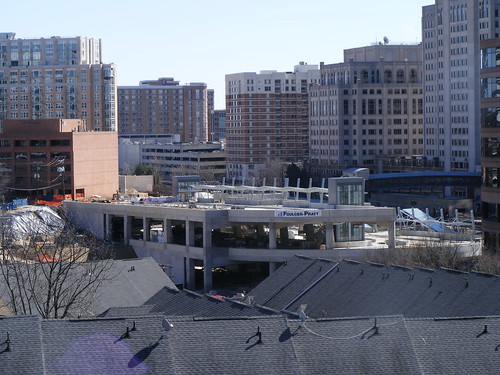
Located next to the Silver Spring Metro station, the transit center is intended as a hub for local, commuter and intercity buses, MARC trains, and the future Purple Line. Construction began in 2008, but stopped over a year ago after workers discovered that the concrete was too thin.
Montgomery County hired KCE Structural Engineers to look at the three-story complex. They found significant construction defects, ranging from improperly laid concrete to columns that don't meet fire codes, which are described in detail in a 100-page report that was published and posted on the county's website two months after its January deadline.
KCE concluded that the situation resulted from a "lack of coordination" between contractor Foulger-Pratt and engineering firm Parsons Brinckerhoff, while the county's independent inspectors from the Robert B. Balter Company failed to report problems or find adequate solutions for them.
The County Council discussed the report in a closed session yesterday afternoon, and County Executive Ike Leggett released a statement expressing dismay at its results. "Unfortunately, the news is not good," he said.
Project plagued by construction errors, lack of oversight
According to KCE's report, discrepancies between Parsons Brinckerhoff's design documents and the working plans drafted by Foulger-Pratt's subcontractors led to improperly installed and treated concrete, which was exposed to harsh winter weather and settled unevenly. The concrete developed cracks and broke away in places, leaving the complex susceptible to water damage and reducing its life expectancy to just 12.5 years when it was supposed to last for 50.
In addition, the transit center's concrete decks, meant to carry buses and other vehicles, aren't as strong as they're supposed to be. In some places, they were built without necessary reinforcing steel.
As previously noted, about 60% of the concrete in the decks were poured too thinly in some places and too thick in others. The slabs were supposed to be roughly 10 inches thick, but in reality, they ranged from 7 to 12 inches. And some columns, while being structurally sound, are thinner than what's allowed by the fire code.
Yet the county's inspectors looked the other way. KCE claims that they "did not raise sufficient concern" about cracks in the concrete and didn't look for a solution. It wasn't until September 2011, when the first reports of deficiencies were made public, that county officials directed Foulger-Pratt to find a fix. When they proposed sealing the cracked concrete with a waterproofing solution, the county said it was insufficient and sought out the help of KCE.
Solutions recommended, but no plan to implement them
While the Transit Center is unsafe, KCE said the building can be saved and strengthened to meet the International Building Code and WMATA's standards. Much of the concrete and reinforcing steel is sound and the structure is strong enough to allow construction to resume.
KCE proposed a variety of "remedial actions" to make the complex stronger and more durable. They include waterproofing the structure, laying new concrete atop areas where it's too thin, replacing concrete slabs that have deteriorated, and strengthening some beams and girders with fiber reinforced polymers.
David Dise, director of the county's Department of General Services, told the Gazette that the transit center "can be fixed, will be fixed," though no cost for the repairs or date for their completion has been given. Since 1999, the project's costs have tripled to $112 million.
Despite the results of the report, Foulger-Pratt insists that Montgomery County is still responsible for the ongoing delays. Last month, they filed a claim against the county.
"Everyone in this community – including us – has been waiting for more than a year for the County to act," said managing principal Bryant Foulger in a prepared statement. "If only the County had been willing to work cooperatively, the Transit Center would have been open by now for the benefit of everyone in Montgomery County."
The Silver Spring Transit Center has been planned for nearly 20 years. It's already one of the region's largest transportation hubs, with nearly 60,000 users each day, and an important part of the revitalization of downtown Silver Spring.
While it's a relief to finally have some answers about what went wrong, new questions have arisen, namely when the parties involved are going to get this long-awaited project finished.

4 comments:
Parsons Brinckerhoff is the same firm that royally screwed up Los Angeles's Expo light rail line, leaving it years behind and way over budget. They consistently screw up projects, and yet people keep hiring them.
I thought the county hired "The Robert B. Balter Company, Inc., a company the county pays to inspect construction projects because the county does not have inspectors on staff"? Aren't they responsible for inspecting the structure?
Sort of tongue in cheek -- sort of: Designate the unfinished transit center a MoCo heritage site and use it to teach future generations about engineering, oversight, business, etc. Heck, just looking at the scale of the f-up and the structure, this is the only place that comes close to being eligible for the title "Historic Monument." Sheesh.
Really seems like the county doesn't have its act together. Frightened about how many more of our tax dollars it will take to fix this mess.
Post a Comment